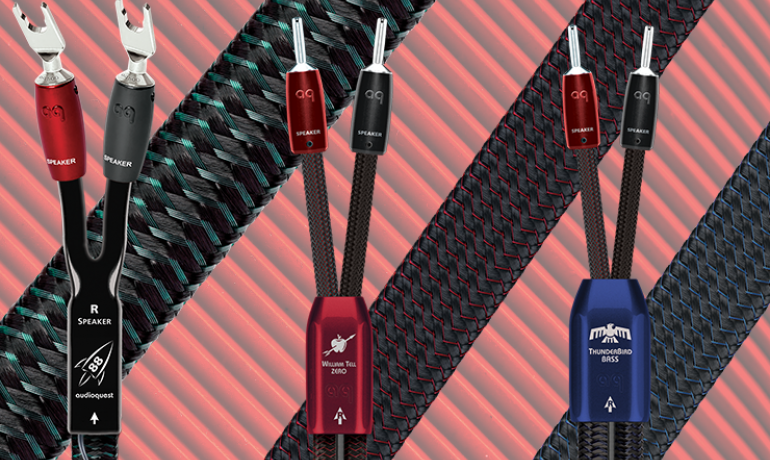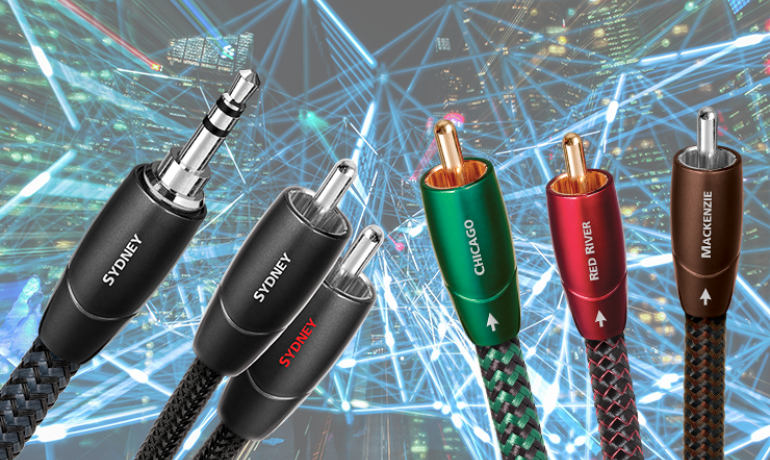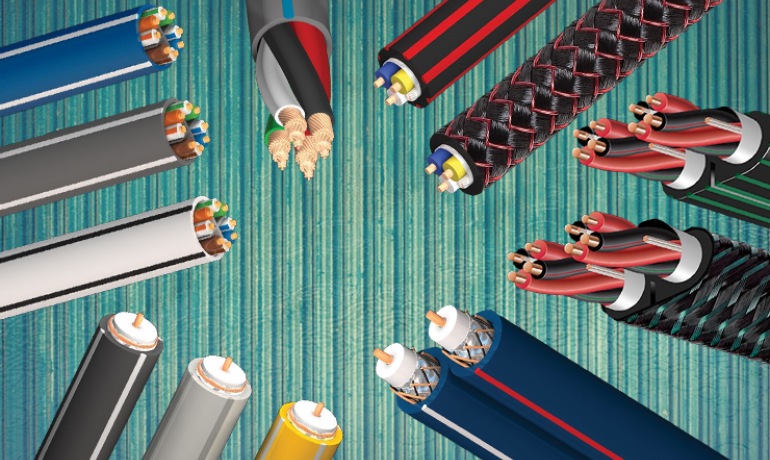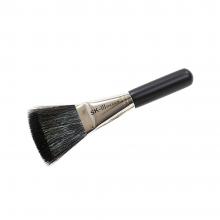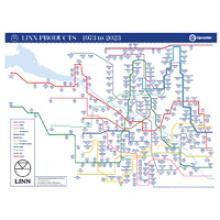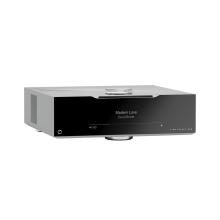AudioQuest Robin Hood SILVER Speaker Cable
Solid perfect-surface silver (PSS) & solid perfectpsurface copper+ (PSC+) conductors
Solid conductors prevent electrical strand-to-strand interaction, major sources of distortion. Surface quality is critical because a conductor can be considered as a rail-guide for both the fields within a conductor, and for the magnetic fields that extend outside the conductor. The astonishingly smooth and pure Perfect-Surface Copper+ eliminates harshness and greatly increases clarity compared to OFHC, OCC, 8N and other premium coppers. Extremely high-purity Perfect-Surface Silver further minimises distortion caused by grain boundaries, which exist within any metal conductor.
Zero-tech (no defined characteristic-impedance) for uncompressed current transfer and linear noise-dissipation
The only complete way to eliminate characteristic-impedance mismatches between a cable and the attached source and load is for the cable not to have any fixed characteristic-impedance value. ZERO-Tech accomplishes this by eliminating interaction between the insulation (dielectric) and the cable’s conductors—enabling uncompressed current transfer. All-important transient current is unrestricted, and RF Noise-Dissipation is linearised (consistent octave to octave).
RF/ND-tech (patented radio-frequency ground-noise dissipation) minimises circuit misbehaviour by cancelling induced RF noise
US Patent # 8,988,168. This extremely effective patented common-mode noise-rejection technology is deployed on the ground path in almost all AudioQuest AC power cables and Niagara Series power products. It is also featured in all AudioQuest BASS (Bass & Midrange only) speaker cables. The unique phase-cancelling array attracts RF energy away from the amplifier’s output. When properly implemented, Bi-Wiring has always been a cost-effective way to get better performance for the same or less money. With RF/ND-Tech, the advantage of Bi-Wiring is much more dramatic. (Note: RF/ND-Tech is so effective it can compromise some low-level audio signals above 10kHz. Its use must be limited to dedicated Bass & Midrange cable applications only. Not recommended for Full-Range use).
72v dielectric-bias system with level-x radio-frequency trap (DBS)
All insulation is also a dielectric whose electrical properties affect the integrity of the signal. When the insulation is unbiased, dielectric-involvement (absorption and non-linear release of energy back into the signal flow) causes different amounts of time delay (phase shift) for different frequencies and energy levels, which is a significant problem for very time-sensitive multi-octave audio. AudioQuest’s multi-patented DBS creates a strong, stable electrostatic field that saturates and polarises (organises) the molecules of the insulation. This minimizes the nonlinear time delays, resulting in clearer sound emerging from a “blacker” background. The Level-X RF Trap (a technology developed for AudioQuest’s Niagara Series of power products) in the DBS battery pack “pulls” RF Noise out of the cable, preventing RF from infiltrating the electronics. DBS Pack batteries last about 10 years. Use the test button to verify condition.
Carbon-based linearised noise-dissipation system (NDS)
Today’s environment is saturated with radio-frequency noise that is extremely difficult to filter or reject. The frequencies of this noise from satellites, cellular towers, and Bluetooth, etc., are so extremely narrow that a conventional shield, or a series or shunt filter, is wholly inadequate. Much of the low-level signal that carries the harmonics and spatial cues that define high-resolution audio is masked by induced radio-frequency noise. AQ’s comprehensive Linearized Noise-Dissipation System combines multiple shields and a carbon-based linearized resistive network that turns most of this noise into heat. In this context, "linearised" means that the system is equally effective across extremely wide bandwidth, rather than at selected frequencies only, as is more common. The remaining bad energy is effectively drained away from the sensitive amplifier circuits via directionally controlled signal and shield conductors.
Robin Hood bi-wiring
When possible, running separate cables to the treble and bass “halves” of a speaker significantly reduces distortion. Bi-Wiring keeps the large magnetic fields associated with bass energy out of the treble cable, allowing the delicate upper frequencies to travel a less magnetically disturbed path, like taking the waves out of the water when you swim. AudioQuest’s RF/ND-Tech (patented RF-Canceling Ground-Noise Dissipation) attracts RF energy away from the amplifier’s output. When properly implemented, Bi-Wiring has always been a cost-effective way to get better performance for the same or less money. With RF/ND-Tech, the advantage of Bi-Wiring is much more dramatic. Because RF/ND-Tech is so effective, BASS model cables are only for 10KHz and below; do not use a BASS cable full-range or on treble. Robin Hood BASS cable is ideal with Robin Hood ZERO or SILVER ZERO. A Bi-Wire COMBO with BASS and ZERO cables joined together at the amplifier is usually most convenient. When Tri-Wiring, use BASS cables on the Midrange and Bass inputs. Caution: Do not Bi-Wire with two ZERO cables. ZERO cables in-parallel can create a very high-frequency resonant peak (ringing), and resulting poor sound. Only use a ZERO plus a BASS cable (whether or not joined as a COMBO). Second best is a single ZERO with AQ Bi-Wire jumpers.
Directionality
All drawn metal strands or conductors have a non-symmetrical, and therefore directional, grain structure. AudioQuest controls the resulting RF impedance variation so that noise is drained away from where it will cause distortion. The correct direction is determined by listening to every batch of metal conductors used in every AudioQuest audio cable. When applicable, arrows are clearly marked on the connectors to ensure superior sound quality. For most models of AQ cable, the arrows not only indicate the direction that optimises metal-directionality as part of Noise-Dissipation, but also indicates non-symmetrical attachment of shield and GND in order to optimise full-system performance.
Folk hero cold-welded terminations
Folk Hero cables are Cold-Welded to AudioQuest’s extremely pure Red Copper Spades or Bananas. The bare copper is submerged (hung) in a vat of pure silver instead of being tumbled in a lower-grade solution. AudioQuest speaker breakouts and plug casings are not metal in order not to induce RF Noise into the conductors.
- Solid perfect-surface silver (PSS) & solid perfectpsurface copper+ (PSC+) conductors
- Zero-tech (no defined characteristic-impedance) for uncompressed current transfer and linear noise-dissipation
- RF/ND-tech (patented radio-frequency ground-noise dissipation) minimises circuit misbehaviour by cancelling induced RF noise
- 72v dielectric-bias system with level-x radio-frequency trap (DBS)
- Carbon-based linearised noise-dissipation system (NDS)
- Robin Hood bi-wiring
- Directionality
- Folk hero cold-welded terminations




